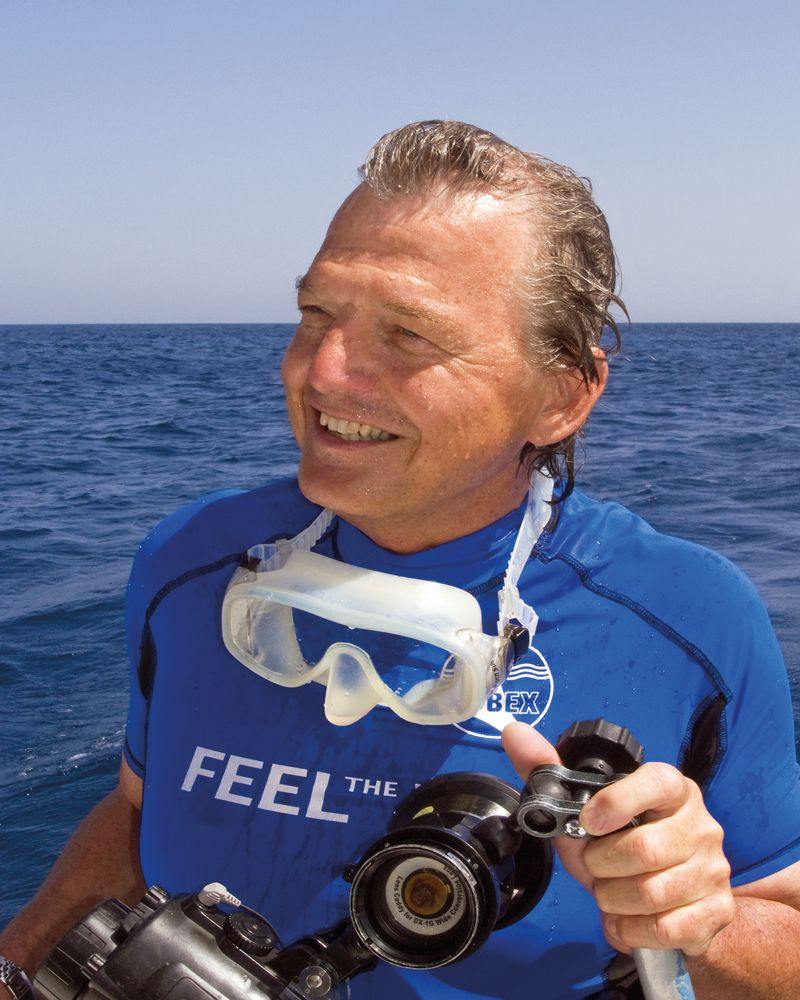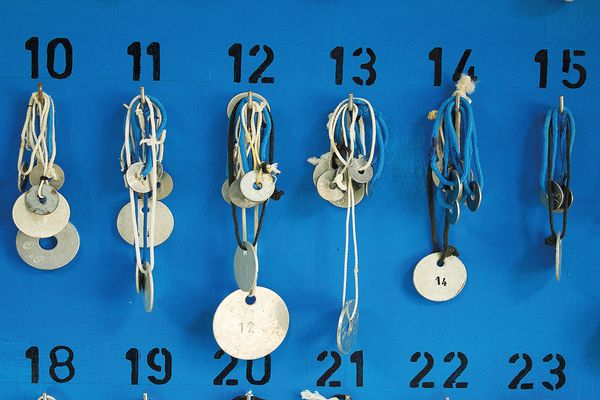Johann Vifian founded Subex in the Red Sea more than 30 years ago. We went diving with him in Sahl Hasheesh
Words and photographs Graeme Gourlay
After an epic 100-minute dive on a shallow reef where we have seen lots of fish and marine life but no other divers, Johann Vifian chuckles as we climb the steps of the jetty. ‘See, I told you,’ he says. ‘No stupid rules!’
The Swiss co-owner of SUBEX, one of the Red Sea’s longest-standing dive businesses, does things differently from many of his competitors.
For, in the past 30 years, the determined Johann and his wife Verena have built up a unique and very special group of dive centres in Sharm El Sheikh, Hurghada and El Quseir under the title of SUBEX – or the rather apt brand of The Art of Diving.
 Johann has been diving in the Red Sea for more than 35 years. Photo: Verena Vivian
Johann has been diving in the Red Sea for more than 35 years. Photo: Verena Vivian
The first thing you notice on visiting one of his centres is the attention to detail and the overwhelming focus on the quality of the diving. This is diving set up for the benefit of the diver, rather than a certification factory or a way of processing as many customers as possible.
There are no more than four divers with each guide or instructor, and frequently fewer. Competent divers are encouraged and supported to do their own thing. There is lots of information provided about the sites and a real interest in what you want to do and experience. Also, as the man says, no petty or daft rules.
As Johann states with pride: ‘We do this for the divers, so people can enjoy safe and well-organised diving. And diving is also an adventure – it is meant to be fun. People have spent good money to come and dive in the Red Sea and we should make it as good as we can.’
Elaborating on his ‘no stupid rules’ philosophy, he told me: ‘When you order a pizza from a restaurant, you don’t expect a waiter to take it away when you are three-quarters of the way through. So why not use as much of the air you have paid for as is safe and sensible?’
The most obvious and striking difference from any other dive centre is that everyone dives on what he calls Air 28 – that is, a 28-per-cent-oxygen mix. It is a perfect example of Johann’s approach. After investing more than €100,000 in new air-fill stations he realised it was relatively inexpensive and simple to output all his air at this mix. He also realised that as long as divers stayed within recommended limits of a maximum depth of 40m, this would not pose any risks of oxygen toxicity. He further worked out that if you were to keep your computer at ‘normal’ setting you must be building in an extra safety factor.
Johann provides this mix to all his divers and asks them to dive with their computers unchanged. This gives his customers the benefits of nitrox, without the cost of doing a further training course – simple, efficient and better for divers.
When asked what other dive centres first thought about him offering enhanced air without charging divers more or putting them through paid-for training courses, he admits: ‘Well, I wasn’t popular to start with. But now most people offer nitrox for no extra cost. We just make sure all our divers can enjoy the same benefits and we don’t force them to pay for an extra course. In fact, we do encourage them to get nitrox certified so they can use it if they go on liveaboards.’
Johann being Johann then encouraged a doctoral student at Dresden University to complete her PhD by comparing diving on Air 28 with the use of normal air using a double-blind field study, which resulted in a published paper proving Johann’s hypothesis that Air 28 is safer. In fact, besides establishing that divers were left with significantly fewer small nitrogen bubbles in their system after diving on the Air 28 mix, the study also concluded that it helped with an individual’s cognitive competence during diving.
 The healthy coral of Sahl Hasheesh. Photo: Herbert Frei
The healthy coral of Sahl Hasheesh. Photo: Herbert Frei
Since he introduced Air 28, he states with pride, none of his centres with more than half a million logged dives has had a decompression sickness (DCS) incident. He says that DAN and similar bodies which study the rate of unexplained incidents of DCS – that is, hits when a dive is carried out within accepted parameters and nothing untoward happens – is about one in every 15,000 dives.
Johann repeatedly refers to ‘our way’ and ‘our methods’ in a near Jedi-like manner when discussing diving with SUBEX.
Here are just a few examples of the little things they do differently. There are neatly labelled rinse tanks – one for regs, with a mild disinfectant, another for cameras and computers, another for boots, one larger one for fins and an even bigger one with spray nozzles for cleaning jackets and suits. The rental kit carries numbered metal tags so no one can get confused about whose perfectly maintained gear is whose. And you are allocated an individual locker with the same number. Plus, the cherry on the cake, the same number is etched on a glass mug you are allocated to use for water and hot drinks for the duration of your stay which hangs neatly on a rack in the centre.
It’s not just in the immaculate dive centres that the differences are apparent. The day boat has its name written on the underside of the hull in vast letters, so you can identify which boat is yours at the end of a dive. And, of course, there is a line with a handle at five metres for your safety stop.
While all this efficiency is a tad unusual compared to the vast majority of dive centres I have encountered, any fears you may have that it might be a precursor to a bureaucratic and bossy attitude around the actual diving are quickly allayed.
Johann’s fiercely loyal staff, who tend to stay with him once they have been inculcated into ‘his way’, are happy to let you get on with your diving without turning into over-controlling nannies once out at sea. This was some of the most relaxing dayboat diving I have ever enjoyed in the Red Sea – no doubt helped by the fact that on most days there were only three other divers aboard, and on one hectic day a grand total of six!
 Anthias on soft coral. Photo: Herbert Frei
Anthias on soft coral. Photo: Herbert Frei
Johann arrived with his wife in the Red Sea in 1985, with plans to stay for a couple of years. He had fallen in love with diving in the Swiss lakes as a teenager, and after completing degrees in architecture and social work had, with Verena, decided they wanted to travel. They were both instructors and first worked in Elba in the Mediterranean. They were among the first divers to visit the Maldives. But they were also looking for a challenge, and when the owners of the dive centre in Elba asked if they wanted to have a crack at setting up a centre in Egypt, they jumped at the chance.
Shrewdly, Johann insisted on having a stake in the business with the founders of SUBEX, his Swiss partners Walti Guggenbühl and René Galster – both pioneer scuba divers and still co-owners of SUBEX, though now in their eighties and taking very backseat roles.
They began with a centre in Hurghada. It was one of the first, when there were only three hotels in the then sleepy Egyptian backwater. Next came an offer to open a dive centre in the early days of Sharm El Sheikh at the Swiss-owned Mövenpick hotel in Na’ama Bay. Then came El Quseir. As tourism in Egypt boomed over the following years, so did Johann and Verena’s business.
The couple of years extended into a few decades and Johann developed his own programme of dive training under the umbrella of the Confédération Mondiale des Activités Subaquatiques (CMAS), which follows his philosophy. His entry-level course is over seven dives, all in open water, where skills are slowly imparted and thoroughly embedded before moving on. There are no more than four students to an instructor and the emphasis is on building confidence and base skills. You end up as a CMAS One Star Diver and for a nominal cost that can be converted into an SSI Open Water card.
Johann and his wife have lived on the outskirts of Hurghada for nearly 35 years and while he is clearly happy in Egypt, his true passion is for the reefs of the Red Sea. ‘We came back from a trip recently, and while it was good to back at home’, he says, ‘I told to my wife “You know, it’s not Egypt we come back for, but the reefs. If they were gone we would have no reason to be here.”’
He was a founder of the Hurghada Environmental Protection and Conservation Association (HEPCA) in 1992, formed originally to solve the problem of boats anchoring on reefs. It has since built up the world’s largest network of mooring buoys for dive boats, stretching more than 1,000km down the Red Sea from Sinai. He is still a very active vice-chairman and the organisation has grown into an effective NGO fighting to protect the marine environment. It is just about to launch an initiative to educate a new influx of tourists about snorkelling in the Red Sea and is heavily involved in working with local schoolchildren to encourage them to be guardians of their reefs.
It hasn’t always been an easy ride. Diving in Egypt peaked in 2011, but following the cumulative impacts of the global recession, fears over political instability in Egypt, and the 2015 terrorist attack on an Aeroflot plane as it took off from Sharm airport, resulting in 253 fatalities, tourist numbers dramatically fell.
‘We had 100 staff, and over a couple of years our diver numbers dropped to less than 10 per cent of what we were doing in the peak,’ he explains. ‘In 2015 we agreed to give it one more year and if it continued to get worse we were going to pack up and head back to Europe.’
Still clearly rattled by how close he had come to losing his life’s work, the relief is etched on his face as he says that, much to their surprise, things turned around the following year and business has been growing steadily in the past few years. ‘We were that close,’ he points out.
They opened their latest centre in the little-known resort of Sahl Hasheesh, a development of six large hotels and seven gated apartment compounds, in 2014. The complex is set around a large shallow bay which is 20km south of Hurghada. It is planned for it to double in size over the next five years and it will rival the similar resort of El Gouna north of Hurghada.
While the diving doesn’t have the advantage that El Gouna has in being a short boat journey to the wrecks of Abu Nuhas (the Giannis D and the Carnatic), it is near enough to Hurghada that you can enjoy the still excellent day-boat diving to sites around the Giftun Islands and, if the weather is calm enough, the wonderful Careless Reef out in more open water.
All in the detail




